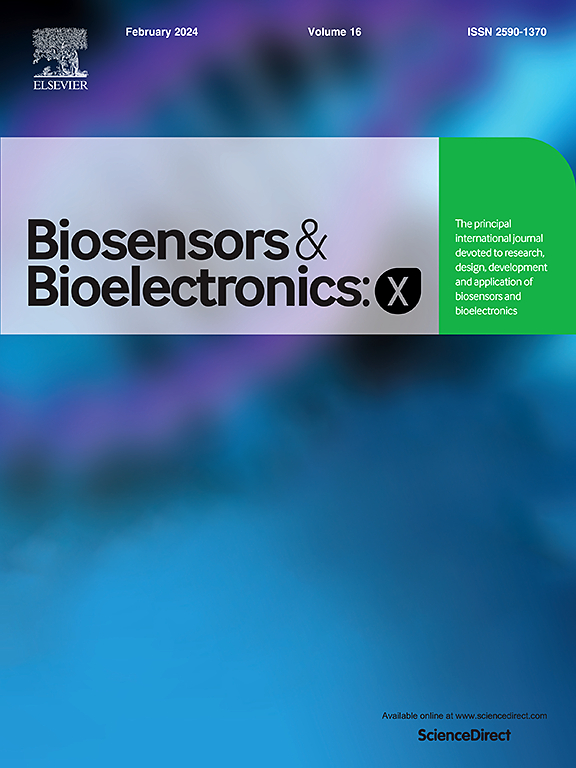Nanostructure modified carbon thread as wearable patch for enzymatic and non-invasive monitoring of glucose from human samples
IF 10.61
Q3 Biochemistry, Genetics and Molecular Biology
引用次数: 0
Abstract
Traditional blood-based glucose detection methods are invasive, inconvenient, and unsuitable for continuous monitoring, highlighting the critical need for a non-invasive alternative. To address this urgent need, we developed a non-invasive and wearable electrochemical glucose sensor patch based on a platinum-copper (Pt-Cu) nanocomposite electrodeposited on carbon cloth thread (CCT) electrode after functionalizing with an electropolymerized polyphenol (Pphe)-glucose oxidase (GOx) film. The immobilization of GOx via the formation of a polyphenol film was done by electropolymerization of phenol in presence of GOx. The detection capability of the developed sensor was evaluated by chronoamperometry analysis and found that the sensor is able to detect glucose with wide linear detection range from 100 to 1500 μM with an ultra-low limit of detection (LOD) of 31.1 μM and 64.4 μM for artificial sweat and urine respectively. In addition, the developed sensor is found to be reproducible, repeatable and highly selective in presence of common interfering molecules present in the human samples. Furthermore, the developed sensor was seamlessly integrated into a wearable prototype device on a commercial bandage with custom made potentiostat circuit called Nanopot. The developed wearable prototype sensor system also exhibits a wide linear detection range from 300 to 1500 μM and a promising LOD of 25.8 μM. These results further validate the reliability, consistency, and practical applicability of the sensor system with a promising potential to address the urgent demand for non-invasive, painless and user-friendly diabetes management.
纳米结构修饰的碳线可穿戴贴片用于人体样品中葡萄糖的酶促和无创监测
传统的血糖检测方法具有侵入性、不方便且不适合连续监测,因此迫切需要一种非侵入性的替代方法。为了解决这一迫切需求,我们开发了一种无创可穿戴的电化学葡萄糖传感器贴片,该贴片基于铂-铜(Pt-Cu)纳米复合材料,经电聚合多酚(Pphe)-葡萄糖氧化酶(GOx)膜功能化后电沉积在碳布线(CCT)电极上。利用苯酚在氧化石墨烯存在下的电聚合,通过形成多酚膜来固定氧化石墨烯。通过计时安培分析对传感器的检测能力进行了评价,发现传感器能够在100 ~ 1500 μM的宽线性检测范围内检测葡萄糖,对人工汗液和尿液的超低检测限(LOD)分别为31.1 μM和64.4 μM。此外,开发的传感器被发现是可重复的,可重复的,在人类样品中存在的常见干扰分子的高度选择性。此外,开发的传感器被无缝集成到商业绷带上的可穿戴原型设备中,该设备带有定制的定位器电路Nanopot。所开发的可穿戴原型传感器系统还具有300 ~ 1500 μM的宽线性检测范围和25.8 μM的有前途的LOD。这些结果进一步验证了传感器系统的可靠性、一致性和实用性,在解决非侵入性、无痛性和用户友好型糖尿病管理的迫切需求方面具有很大的潜力。
本文章由计算机程序翻译,如有差异,请以英文原文为准。
求助全文
约1分钟内获得全文
求助全文
来源期刊

Biosensors and Bioelectronics: X
Biochemistry, Genetics and Molecular Biology-Biophysics
CiteScore
4.60
自引率
0.00%
发文量
166
审稿时长
54 days
期刊介绍:
Biosensors and Bioelectronics: X, an open-access companion journal of Biosensors and Bioelectronics, boasts a 2020 Impact Factor of 10.61 (Journal Citation Reports, Clarivate Analytics 2021). Offering authors the opportunity to share their innovative work freely and globally, Biosensors and Bioelectronics: X aims to be a timely and permanent source of information. The journal publishes original research papers, review articles, communications, editorial highlights, perspectives, opinions, and commentaries at the intersection of technological advancements and high-impact applications. Manuscripts submitted to Biosensors and Bioelectronics: X are assessed based on originality and innovation in technology development or applications, aligning with the journal's goal to cater to a broad audience interested in this dynamic field.
 求助内容:
求助内容: 应助结果提醒方式:
应助结果提醒方式:


